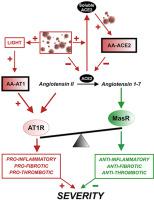Journal of Autoimmunity ( IF 7.9 ) Pub Date : 2021-06-11 , DOI: 10.1016/j.jaut.2021.102683 Ana I Rodriguez-Perez 1 , Carmen M Labandeira 2 , Maria A Pedrosa 1 , Rita Valenzuela 1 , Juan A Suarez-Quintanilla 3 , María Cortes-Ayaso 4 , Placido Mayán-Conesa 4 , Jose L Labandeira-Garcia 1

|
The renin-angiotensin system (RAS) plays a major role in COVID-19. Severity of several inflammation-related diseases has been associated with autoantibodies against RAS, particularly agonistic autoantibodies for angiotensin type-1 receptors (AA-AT1) and autoantibodies against ACE2 (AA-ACE2). Disease severity of COVID-19 patients was defined as mild, moderate or severe following the WHO Clinical Progression Scale and determined at medical discharge. Serum AA-AT1 and AA-ACE2 were measured in COVID-19 patients (n = 119) and non-infected controls (n = 23) using specific solid-phase, sandwich enzyme-linked immunosorbent assays. Serum LIGHT (TNFSF14; tumor necrosis factor ligand superfamily member 14) levels were measured with the corresponding assay kit. At diagnosis, AA-AT1 and AA-ACE2 levels were significantly higher in the COVID-19 group relative to controls, and we observed significant association between disease outcome and serum AA-AT1 and AA-ACE2 levels. Mild disease patients had significantly lower levels of AA-AT1 (p < 0.01) and AA-ACE2 (p < 0.001) than moderate and severe patients. No significant differences were detected between males and females. The increase in autoantibodies was not related to comorbidities potentially affecting COVID-19 severity. There was significant positive correlation between serum levels of AA-AT1 and LIGHT (TNFSF14; rPearson = 0.70, p < 0.001). Both AA-AT1 (by agonistic stimulation of AT1 receptors) and AA-ACE2 (by reducing conversion of Angiotensin II into Angiotensin 1-7) may lead to increase in AT1 receptor activity, enhance proinflammatory responses and severity of COVID-19 outcome. Patients with high levels of autoantibodies require more cautious control after diagnosis. Additionally, the results encourage further studies on the possible protective treatment with AT1 receptor blockers in COVID-19.
中文翻译:

针对 ACE2 和血管紧张素 1 型受体的自身抗体会增加 COVID-19 的严重程度
肾素-血管紧张素系统 (RAS) 在 COVID-19 中起着重要作用。几种炎症相关疾病的严重程度与抗 RAS 自身抗体有关,尤其是血管紧张素 1 型受体 (AA-AT1) 的激动性自身抗体和抗 ACE2 自身抗体 (AA-ACE2)。COVID-19 患者的疾病严重程度根据 WHO 临床进展量表定义为轻度、中度或重度,并在出院时确定。使用特定的固相夹心酶联免疫吸附测定法在 COVID-19 患者 (n = 119) 和未感染的对照组 (n = 23) 中测量了血清 AA-AT1 和 AA-ACE2。使用相应的测定试剂盒测量血清 LIGHT(TNFSF14;肿瘤坏死因子配体超家族成员 14)水平。在诊断时,与对照组相比,COVID-19 组的 AA-AT1 和 AA-ACE2 水平明显更高,我们观察到疾病结果与血清 AA-AT1 和 AA-ACE2 水平之间存在显着相关性。轻度疾病患者的 AA-AT1 (p < 0.01) 和 AA-ACE2 (p < 0.001) 水平显着低于中度和重度患者。男性和女性之间没有发现显着差异。自身抗体的增加与可能影响 COVID-19 严重程度的合并症无关。血清 AA-AT1 水平与 LIGHT(TNFSF14;r 男性和女性之间没有发现显着差异。自身抗体的增加与可能影响 COVID-19 严重程度的合并症无关。血清 AA-AT1 水平与 LIGHT(TNFSF14;r 男性和女性之间没有发现显着差异。自身抗体的增加与可能影响 COVID-19 严重程度的合并症无关。血清 AA-AT1 水平与 LIGHT(TNFSF14;r皮尔逊 = 0.70,p < 0.001)。AA-AT1(通过激动性刺激 AT1 受体)和 AA-ACE2(通过减少血管紧张素 II 向血管紧张素 1-7 的转化)可能导致 AT1 受体活性增加,增强促炎反应和 COVID-19 结果的严重程度。自身抗体水平高的患者在诊断后需要更加谨慎的控制。此外,该结果鼓励进一步研究 AT1 受体阻滞剂在 COVID-19 中可能的保护性治疗。











































 京公网安备 11010802027423号
京公网安备 11010802027423号